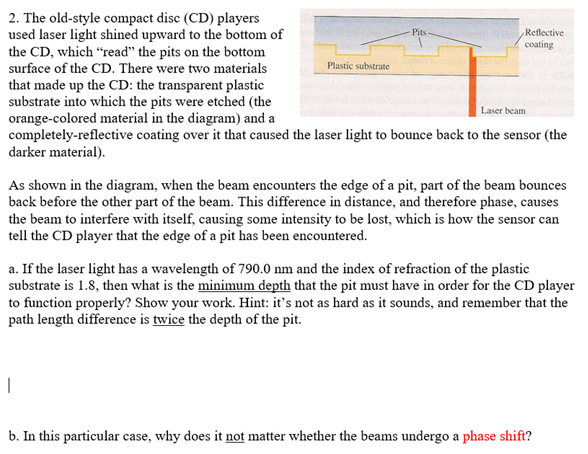2. The old-style compact disc (CD) players used laser light shined upward to the bottom of the CD, which "read" the pits on the bottom surface of the CD. There were two materials that made up the CD: the transparent plastic substrate into which the pits were etched (the orange-colored material in the diagram) and a completely-reflective coating over it that caused the laser light to bounce back to the sensor (the darker material). Laser beam Plastic substrate Pits I Reflective coating As shown in the diagram, when the beam encounters the edge of a pit, part of the beam bounces back before the other part of the beam. This difference in distance, and therefore phase, causes the beam to interfere with itself, causing some intensity to be lost, which is how the sensor can tell the CD player that the edge of a pit has been encountered. a. If the laser light has a wavelength of 790.0 nm and the index of refraction of the plastic substrate is 1.8, then what is the minimum depth that the pit must have in order for the CD player to function properly? Show your work. Hint: it's not as hard as it sounds, and remember that the path length difference is twice the depth of the pit. b. In this particular case, why does it not matter whether the beams undergo a phase shift?
2. The old-style compact disc (CD) players used laser light shined upward to the bottom of the CD, which "read" the pits on the bottom surface of the CD. There were two materials that made up the CD: the transparent plastic substrate into which the pits were etched (the orange-colored material in the diagram) and a completely-reflective coating over it that caused the laser light to bounce back to the sensor (the darker material). Laser beam Plastic substrate Pits I Reflective coating As shown in the diagram, when the beam encounters the edge of a pit, part of the beam bounces back before the other part of the beam. This difference in distance, and therefore phase, causes the beam to interfere with itself, causing some intensity to be lost, which is how the sensor can tell the CD player that the edge of a pit has been encountered. a. If the laser light has a wavelength of 790.0 nm and the index of refraction of the plastic substrate is 1.8, then what is the minimum depth that the pit must have in order for the CD player to function properly? Show your work. Hint: it's not as hard as it sounds, and remember that the path length difference is twice the depth of the pit. b. In this particular case, why does it not matter whether the beams undergo a phase shift?
Chapter9: Optics
Section: Chapter Questions
Problem 51Q
Related questions
Question

Transcribed Image Text:2. The old-style compact disc (CD) players
used laser light shined upward to the bottom of
the CD, which "read" the pits on the bottom
surface of the CD. There were two materials
that made up the CD: the transparent plastic
substrate into which the pits were etched (the
orange-colored material in the diagram) and a
completely-reflective coating over it that caused the laser light to bounce back to the sensor (the
darker material).
Laser beam
Plastic substrate
Pits
I
Reflective
coating
As shown in the diagram, when the beam encounters the edge of a pit, part of the beam bounces
back before the other part of the beam. This difference in distance, and therefore phase, causes
the beam to interfere with itself, causing some intensity to be lost, which is how the sensor can
tell the CD player that the edge of a pit has been encountered.
a. If the laser light has a wavelength of 790.0 nm and the index of refraction of the plastic
substrate is 1.8, then what is the minimum depth that the pit must have in order for the CD player
to function properly? Show your work. Hint: it's not as hard as it sounds, and remember that the
path length difference is twice the depth of the pit.
b. In this particular case, why does it not matter whether the beams undergo a phase shift?
Expert Solution
This question has been solved!
Explore an expertly crafted, step-by-step solution for a thorough understanding of key concepts.
Step by step
Solved in 4 steps with 3 images

Knowledge Booster
Learn more about
Need a deep-dive on the concept behind this application? Look no further. Learn more about this topic, physics and related others by exploring similar questions and additional content below.Recommended textbooks for you


Physics for Scientists and Engineers, Technology …
Physics
ISBN:
9781305116399
Author:
Raymond A. Serway, John W. Jewett
Publisher:
Cengage Learning

College Physics
Physics
ISBN:
9781938168000
Author:
Paul Peter Urone, Roger Hinrichs
Publisher:
OpenStax College


Physics for Scientists and Engineers, Technology …
Physics
ISBN:
9781305116399
Author:
Raymond A. Serway, John W. Jewett
Publisher:
Cengage Learning

College Physics
Physics
ISBN:
9781938168000
Author:
Paul Peter Urone, Roger Hinrichs
Publisher:
OpenStax College

Principles of Physics: A Calculus-Based Text
Physics
ISBN:
9781133104261
Author:
Raymond A. Serway, John W. Jewett
Publisher:
Cengage Learning